
History of Pirate Surgeons Menu: 1 2 3 4 5 6 7 8 9 10 11 12 Next>>
The History of Sea and Pirate Surgeons, Page 8
Some Unnamed Surgeons' Adventures During the Golden Age of Piracy
There are several accounts of unnamed surgeons among the pirates worth mentioning here.
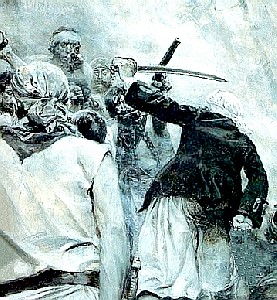
Artist: Howard Pyle (1894)
Fighting back the men with a sword
The first involves Captain John Halsey's surgeon, who decided to help a mutinying crew stick to their intentions. Captain Halsey was sailing the Red Sea searching for Moorish ships. He had decided not to take any European ships, a rule with which his crew disagreed. So they locked him and his gunner up and tried to take a Dutch ship of 60 guns which they had come across while seeking Moors. The Dutch ship proved unwilling to be taken. According to Johnson, "the Men perceiving they had catch'd a Tartar, made the best of their Way to shake her off, and some were running down between Decks, whom the Surgeon prick'd up again with his Sword, tho' he was no Way consenting to their design'd piracy."1
The second unnamed surgeon was instrumental in saving the entire crew of Captain John Bowen's ship the Speedy Return from dying of thirst. North's crew got caught in a storm which caused them to throw most of their cargo overboard and stave (break open) their casks of water. When the storm was over, they met a fishing vessel and sent their canoe to the fishermen to learn where they might find water.
Rather
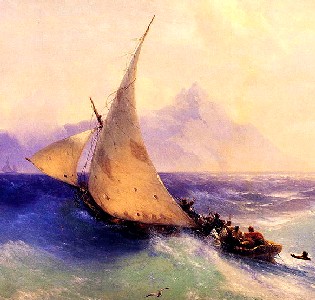
Artist: Ivan Aivazovsky (1872) - Rescue at Sea Detail
than be taken by pirates, the fishermen jumped overboard and either swam ashore or drowned trying. One unlucky soul failed to do either, but spent an hour and a half escaping them by diving every time the pirate's canoe caught up with him.
Frustrated, Captain North "took the Sprit [a long pole that goes from one corner of a sail to the opposite corner], and struck him as he rose, hoping to disable him, but he broke his Jaw. They took him by this Means, brought him on board, sent him to the surgeon, and when they despair'd of his being able to speak, he asked for a Pipe of Tobacco, which he smoak'd, and drunk a Dram; after which he seem'd very hearty."2
They promised to free him if he would lead them to fresh water. Agreeing, "he carry'd them to a convenient landing Place, where he shewed a Well full of Dirt, out of which, after a great deal of Trouble to come at it, they drew but three Buckets of Water, which sufficed those only who went on Shore, to the number of 30."3 Furious, the pirates threatened to kill the fisherman. He explained that "if they would have Patience till the Sun was set, they would have Plenty, for the Spring would rise, and flow all Night; which they found to be the Fact, and filled twenty Tun of Water, and return'd on board".4
One unnamed surgeon helped Louis Guittard and his crew procure a better ship. While sailing among the Lesser Antilles, the crew "relieved a small Dutch trading ship of its cargo of linens and its surgeon."5 The pressed doctor told the pirates about an ship which would be of great use to them that had recently sailed for Isla Tortuga, off northeastern Venezuela. "Guittard testified [at his trial] that the captive surgeon had told them that he had done this 'in spite, to be revenged upon the master of the ship, who had wronged him of 6 or 700 crowns.'"6 This resulted in their capture of a Dutch ship of 140 tons which the pirates converted into their flagship, calling it La Paix.
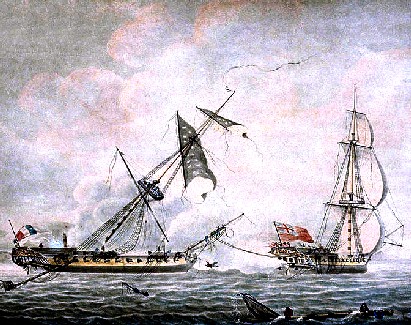
Artist: Robert Dodd- English Ship Towing Captured Prize (1800s)
An unnamed surgeon aboard Samuel Bellamy's ship, most likely James Ferguson, was the reason one captured man decided to stay aboard the pirates, according to his testimony at the trial. "John Shuan, by his Interpreter, Saith That he was sick at the time when Capt. Bellamy took him, and went on board the Pyrate Vessel at the Instance of Capt. Bellamy's Doctor, who advised him to stay with him till his Cure."7 This either says a lot about Bellamy's surgeon or little about Shuan's ability to come up with a good excuse for remaining aboard a pirate ship. The court didn't buy it; Shuan was executed for piracy.
Another unnamed surgeon, "who was carried on board the pirate" ship John and Rebecca captained by John Hore gave an account of his time with them when he was captured in August of 1696. This surgeon testified that Hore had captured two merchant vessels - the Ruparrell and Calicut - which he tried to ransom and instead burned when no one at Aden (in what is today Yemen) would pay him. He said that they next sailed for the Persian Gulf, careening on an island along the way and then took a 'county' ship. After that, the anonymous surgeon "being set ashore at Gambroon, can tell nothing further of their proceedings."8
A surgeon is mentioned in passing as being taken by pirates. Captain Thomas Warren's ship John was captured by what appeared to be a French 'privateer', they "detain’d him three days, plunder’d him of what they thought meet [suitable], took away his Surgeon and five of his Men"9.
1 Daniel Defoe (Captain Charles Johnson), A General History of the Pyrates, Manuel Schonhorn, ed., 1999, p. 465; 2 Defoe (Captain Charles Johnson), p. 521; ,3,4 Defoe (Captain Charles Johnson), p. 522; 5,6 David Marley, Pirates of the Americas, Vol. 2, 2010, p. 621; 7 John Franklin Jameson, “112. Trial of Simon van Vorst and Others. [October], 1717.”, Privateering and Piracy in the Colonial Period – Illustrative Documents, p. 260; 8 CSPC America and West Indies, Vol. 16, Item 115; 9 Flying Post or The Post Master, 8-14-01 - 8-16-01, Issue 979
The Misfortunes of Pirate Surgeons
Sea surgeons were always in a precarious position when their ship was captured by pirates. Since they didn't normally sign the articles, they didn't have a vote in the affairs of the moment and so were at the mercy of those pirates who could vote. When the combined crews of Oliver Levasseur and John (Richard) Taylor were voting to decide whether they would accept the King's pardon for pirates, surgeon's mate Richard Moor, along with "Thomas Arrett an English surgeon and Mr Snear a Dutch surgeon 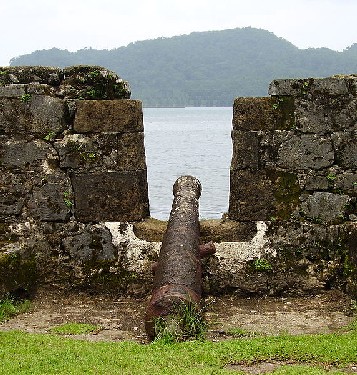
Photo: Gail Frederick - Port San Lorenzo, Portobello
...did not go on board the Guelderland by reason that the Surgeons had no Vote there."1 Taylor's pirates chose to leave the profession if a general pardon was available to pirates. (The King issued such pardons as a soft attempt to stop piracy.)
Most likely because they were less likely to be captured because of their station, all three surgeons were sent to Portobello, Panama to determine whether a pardon was available to pirates. Upon learning there was they requested pardon for Taylor's pirates. Although it was somewhat unfortunate that these men were not allowed to vote and had to undertake the potentially dangerous journey to find out about the pardon, this story has a relatively happy ending for Moor, in that he was released from the pirates service.2
Several surgeons received rough treatment at the hands of their captors. When surgeon John Crawford's ship, the merchant vessel Greyhound, was taken off Honduras in 1722 by George Lowther, he "was singled out for torture with lighted fuses between his fingers to reveal the whereabouts of some concealed gold dust"3. (It is not indicated whether he thereafter served as a surgeon aboard Lowther's ship Happy Delivery.)
William Parker was forced aboard pirate Thomas Anstis' ship where he says, "I had no Liberty there, but what was by Compulsion."4 Parker reports "[I] was very much abused in the time that I was on Board the Good Fortune, which was about ten or eleven Weeks. The Pirates beat me several times; they put burning Match betwixt my Fingers; and twice I was thrown Over-board"5. Pirate Bridstock Weaver asked Parker how he liked being on the ship. Parker replied that he didn't. "You say very right, Doctor, (says Weaver) for I am a Prisoner as well as you; but your Ship fell in our way, and we were oblig’d to speak with ye; and therefore as you have run your Hand into the Lyon’s Mouth, your best way will be to draw it out again as easily as you can."6
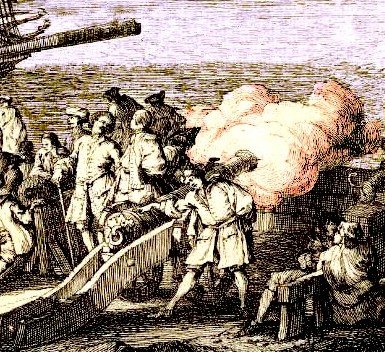
Photo: Jacques Rigaud Jacque
Firing Cannon, From Alere au Depart Avec Coup de Canon (1750)
The surgeon's life itself was always at risk. The crew tried to keep them safe by putting them in the hold, cable tier or orlop deck, which was at or below the waterline and less likely to be damaged by cannon fire. Yet there are still examples of pirate surgeons perishing at sea (and probably still more examples of those not mentioned in the golden age of piracy accounts dying without record.) When the forced men took back control of John Phillips ship Squirrel, they accidentally killed an unnamed, forced French surgeon when a swivel gun misfired.7
Howell Davis took several men including 'his first surgeon' into Principe, prior to an intended attack of the town, to see the governor. On inquiring at the governor's house, the pirates were told the governor was not at home, but would soon be there. "But the Surgeon observing, that many People had got together in the Street, with Arms in their hands, he said to his Captain, ‘I am sure we shall see no Governor to day,’ and advised him immediately to go away."8 Upon leaving the house, the surgeon and two others were shot and killed and Davis was wounded and eventually died before he could reach his ship.
Sometimes it was just unfortunate fate that the surgeon died. Samuel Bellamy's surgeon, James Ferguson, was drowned when Bellamy's ship the Whydah Galley sank off Cape Cod in 1717.9
1 “44. Richard Moor, from The Examination of Richard Moor, 31 October, 1724. HCA 1/55, ff. 94-97”, Pirates in Their Own Words, Ed Fox, ed., 2014, p. 210; 2 “44. Richard Moor...", p. 210-1; 4 “61. Bridstock Weaver and William Ingram, The Proceedings on the King's Commission of Oyer and Terminer... (London, 1725)", Pirates in Their Own Words, Ed Fox, ed., 2014, p. 327; 5 “61. Bridstock Weaver...", p. 326-7; 6 “61. Bridstock Weaver...", p. 327; 7 George Francis Dow and John Henry Edmonds, The Pirates of the New England Coast 1630-1730, 1996, p. 313; 8 Captain William Snelgrave, A New Account of Some Parts of Guinea and the Slave Trade, 1734, p. 282-3; 9 “Dr. James Ferguson”, Science Museum of Minnesota website, gathered 6/13/12
Thomas Guy - A Most Unfortunate Ship's Surgeon
Thomas Guy was the surgeon aboard the George Galley before the crew mutinied.1 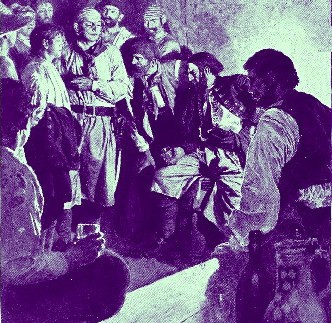
Artist: Howard Pyle
Rogues a Plotting - Jack Ballister's Fortunes (1894)
He never actually became a pirate surgeon, but the reason for this was not to his advantage. The Ordinary of Newgate Prison reported that before the mutiny, James Williams and John Gow had hinted during discussions with their fellow sailors that they wanted to turn pirate. The other sailors took these comments as jokes, but not surgeon Guy who had overhead them. He "took them up short once, for so much as mentioning such a Thing, told them the Thought was Criminal, and it ought not to be spoken of among them. Which Reproof ‘twas supposed cost him his Life afterwards."2
Some time later, Gow and his compatriots captured the ship by sneaking out of their hammocks late at night "and going in the Dark to the Hammocks of the Chief Mate, Super-Cargo, and Surgeon, they cut all their Throats, the Surgeon’s Throat was cut so effectually, that he could struggle very little with them, but leaping out of his Hammock, ran up to get upon the Deck, holding his Hand upon his Throat, but stumbled at the Tiller, and falling down, had no Breath, and consequently no Strength to raise himself, but dy’d where he lay."3 Gow's pirate crew decided to throw him and the other murdered crew members overboard because they "lay in their Way, and that was soon done, their Pockets being first searched and rifled"4.
1 Daniel Defoe (Captain Charles Johnson), A General History of the Pyrates, Manuel Schonhorn, ed., 1999, p. 359; 2 Select and Impartial Accounts of the Lives, Behavior, and Dying-Words Of the most Remarkable Convicts, Vol. II, 1745, p. 211; 3 Select and Impartial Accounts, p. 212-3; 4 Select and Impartial Accounts, p. 215
Helpful Pirate Surgeons?
Some of the pirate surgeons were enlisted to help the pirates in ways other than their traditional role. One example already mentioned in the previous section is Howell Davis's first surgeon. Along with Davis, "the Master and Doctor, dressed themselves like Gentlemen; his Design being, that the Men Should look like common Sailors, and they like Merchants."1 Unfortunately, as explained, this led to the surgeon's untimely demise. It is not entirely clear whether the surgeon did this freely or under duress.
In similar fashion, when a ship was captured by his pirates, "Capt. Greenway, the Gunner, Doctor and other officers went Immediately on board the Ship"2 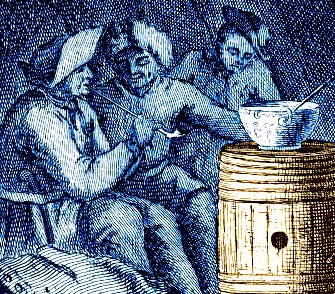
Artist: Joseph Nicholls - Pirates Drinking & Smoking (1736)
. Why the surgeon went is not clear, but it is very likely he went to remove any medicines or surgical instruments the pirates lacked. Pirates had few legitimate methods for procuring such things.
Another surgeon accustomed to the pirates' advantage was Captain James Allison's doctor. Allison's sloop had been anchored by Master Jeremiah Tay's ship Good Hope for several days in January of 1691 without Tay suspecting that they were pirates. Allison invited Tay, his supercargo and a passenger aboard his sloop
to Drinke a glasse of Punch with them, which he did, and when we were come on board the said Sloope they pretended theire Doctor (whom wee Left on board the Shipp talkeing with our men) had the keys where theire Sugar was, Soe they could not make the Punch, and forthwith severall of them Stept into the Boate and Rowdd on board our Shipp to fetch the keys. as Soone as they entred our Shipp one of them Ran to the Steereage Doore and another to the Round house and Secured all our Arms3
The pirates captured the ship, firing a gun to let the men on the sloop know that they should secure Tay and his 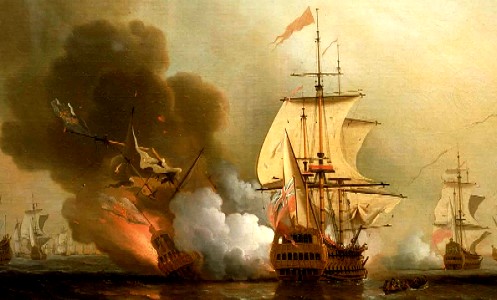
Artist: Samuel Scott - Charles Wager Attacking Spanish Ships off Caregena in 1708 (18th century)
shipmates. They then moved everything of use to them from their sloop onto Tay's ship and sailed away, leaving Tay with their old sloop. Whether the surgeon was a willing accomplice is not evident from Tay's deposition.
Surgeons were sometimes also helpful to the pirates' victims. When pirate Joseph Cooper's men captured the merchant ship Perry Galley on November 9th, 1725, they took the ship "to the Island of Aruba... where they sat the Crew ashore and left them for seventeen Days without any Provision, except that he Surgeon of the Pirate now and then brought them something by stealth."4 This unnamed surgeon was eventually caught, from which we learn his family name. When the Diamond Man-of-War caught up with the pirates shortly thereafter, an observer reported, "Mr. Bridge has also taken one Lawrence, Surgeon to Cooper"5, almost certainly the generous pirate surgeon mentioned assisting the prisoners on Aruba.
1 Captain Charles Johnson, A general history of the pirates, 2nd Edition, 1724, p. 181; 2 “39. Richard Appleton and others, from Minutes of the Provincial Council of Pennsylvania,, vol. III (Philidelphia, 1852) pp. 50-52”, Pirates in Their Own Words, Ed Fox, ed., 2014, p. 188; 3 53. Declaration of Jermiah Tay and Others, March, 1691”, Privateering and Piracy in the the Colonial Period - Illustrative Documents, John Franklin Jameson, ed., p. 139; 4 "The Life of John Upton", The Lives of the Most Remarkable Criminals who Have Been Condemned, Volume 3, Arthur L. Hayes, ed., 1735, p. 112; 5 Daily Journal, 8-20-26, Issue 1747

